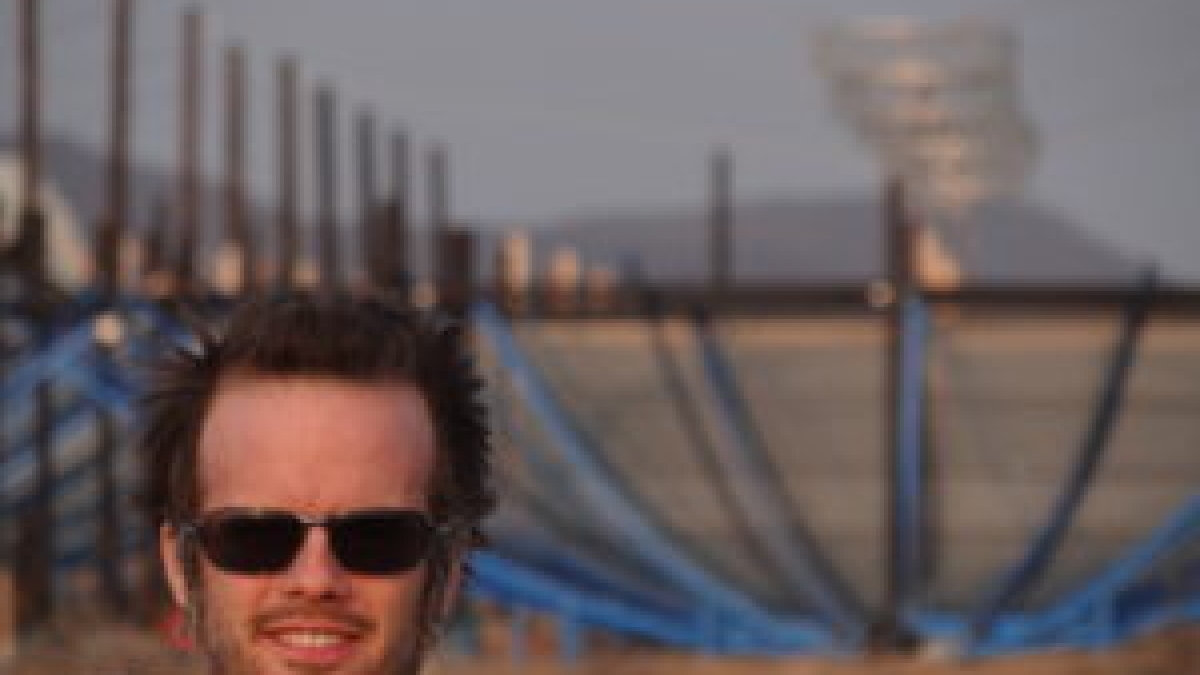ASU Assistant Professor Daniel Jacobs selected for prestigious NSF CAREER award

Assistant Professor Daniel Jacobs at the HERA radio telescope site in South Africa. Credit Beardsley/ASU
The National Science Foundation (NSF) has selected Arizona State University School of Earth and Space Exploration Assistant Professor Daniel Jacobs to receive the prestigious Faculty Early Career Development (CAREER) program award.
The NSF CAREER program is a foundationwide activity that offers awards in support of early-career faculty who have the potential to serve as academic role models in research and education and to lead advances in the mission of their department.
Jacobs is an interdisciplinary scientist across the areas of astrophysics, cosmology, experimental physics and aerospace engineering. His primary research focus is measuring cosmological signatures of the first stars and galaxies in the early universe with custom radio arrays.
Jacobs’ award was given within the division of astronomical sciences at NSF to support a five-year program of research and development by his group of students and postdoctoral scholars.
The funds will be used for observation with existing radio arrays, to improve radio arrays and to develop new technology to support future experiments.
“Our team is working on instruments to observe the radio signal emitted from hydrogen gas during the Cosmic DawnThe period from about 50 million years to 1 billion years after the Big Bang when the first stars, black holes and galaxies in the universe formed.,” Jacobs says. “These observations would resolve many open questions about how galaxies came to be, but owing to the extreme distance, the time period has yet to be observed.”
Jacobs and his team plan to develop advanced instrument calibration tools and techniques for two 21cm cosmology instruments currently under construction at the Hydrogen Epoch of Reionization Array (HERA) and the Owens Valley Long Wavelength Array (OVRO-LWA).
In addition, this award will provide stipends for students in both the Research Experience for Non-Traditional Undergraduates (RENTU) program and for Jacobs’ graduate students who are leading contributions to the Completely Hackable Amateur Radio Telescope (CHART) program. The graduate students will design kits and provide expert guidance to high school students and teachers so that they can build their own radio telescope to observe hydrogen gas in the Milky Way.
“Professor Jacobs’ research group is doing innovative work that integrates leading-edge research in the astronomical sciences with technology development and actual hands-on opportunities for students,” says Meenakshi Wadhwa, School of Earth and Space Exploration director. “We are proud that his work is being recognized by this NSF CAREER award because he exemplifies our faculty’s commitment to excellence in research, teaching and mentoring.”
Jacobs is the co-director of the Low Frequency Cosmology Lab at ASU, where scientists observe high redshift cosmology at low radio frequencies and develop space-based astronomy, among other activities. These projects include major contributions to HERA, the Murchison Widefield Array, OVRO-LWA and ASU’s Star-Planet Activity Research Cubesat (SPARCS) cubesat. Internal projects at the lab include developing new technology, like drone-based radio calibration, novel signal processing and precision radio design. In addition, he is the associate director of the ASU Interplanetary Initiative and director of the Interplanetary Initiative Lab, which supports cubesats and other small space missions.
“My colleagues and I are attempting to open a new window on the universe using the radio band most notable for containing FM broadcasts,” Jacobs says. “It is a big challenge, but worth the effort to be able to see a time period otherwise almost completely invisible. An award like this allows us to take a longer view of the problems we face and do the job properly. Only a handful of awards like this are made each year. It is an honor and a big responsibility.“
More Science and technology

4 ASU researchers named senior members of the National Academy of Inventors
The National Academy of Inventors recently named four Arizona State University researchers as senior members to the prestigious…

Transforming Arizona’s highways for a smoother drive
Imagine you’re driving down a smooth stretch of road. Your tires have firm traction. There are no potholes you need to swerve to…

The Sun Devil who revolutionized kitty litter
If you have a cat, there’s a good chance you’re benefiting from the work of an Arizona State University alumna. In honor of…

